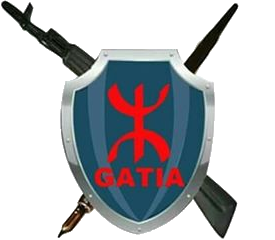
The Imghad Tuareg Self-Defense Group and Allies is an armed group in Azawad, Mali. Most of its 500 to 1,000 fighters are Imghad Tuaregs, and the group supports the Malian government.
El Hadj Ag Gamou, born December 31, 1964, in Tidermène, Mali, is an Imghad Tuareg Malian division general. Gamou is currently the governor of Kidal Region since November 22, 2023, and has also been the head of his faction of Imghad Tuareg Self-Defense Group and Allies since the group's foundation. Prior to his governorship, Gamou served in the Malian army, commanding Malian troops against Ansar Dine and the National Movement for the Liberation of Azawad (MNLA) in the early stages of the Mali War.

The High Council for the Unity of Azawad (HCUA) (French: Haut conseil pour l'unité de l'Azawad) is a Tuareg political movement formed on May 2, 2013, during the Mali War. The movement was initially called the High Council of Azawad (HCA) (French: Haut conseil de l'Azawad) before changing its name on May 19, 2013.
On July 26, 2017, clashes broke out between the pro-government GATIA Imghad Tuareg militia and anti-government Idnane Tuareg rebels from the Coordination of Azawad Movements.
On 10 August 2016, clashes broke out between pro-government GATIA militiamen against Coordination of Azawad Movements (CMA) aligned groups near Adjlal, Kidal Region, Mali.
On July 30, 2016, clashes broke out between GATIA and the Coordination of Azawad Movements in Touzik, Kidal Region, Mali.
Between December 24–25, 2015, Ansar Dine militants attacked National Movement for the Liberation of Azawad (MNLA) positions in Talahandak, Mali. Ansar Dine captured the MNLA outpost, and then ambushed CMA reinforcements.

Alghabass Ag Intalla is a Malian Tuareg politician and prominent leader of the High Council for the Unity of Azawad and the Coordination of Azawad Movements.
On August 17, 2015, clashes broke out between pro-government GATIA militants and rebels from the Coordination of Azawad Movements (CMA) in the town of Anefis and surrounding areas. The dispute was settled in September.
Cheikh Ag Aoussa, nom de guerre Abou Mohame, was a Tuareg rebel leader and prominent drug trafficker.
On January 28 and February 4, 2015, pro-government Imghad Tuareg GATIA fighters attacked a base staffed by Arab Movement of Azawad (MAA) fighters in Tabrichat, Mali.
Achafghi Ag Bohada is a Malian Tuareg rebel and Chief of staff of the High Council for the Unity of Azawad.
Between January 16 and 20, 2015, Platform and the Coordination of Azawad Movements clashed in the town of Tabankort, Gao Region, Mali. The clashes sparked a conflict between the CMA and the Dutch contingent of MINUSMA, which led to a controversial demilitarized zone.

On October 16, 2014, clashes broke out between the pro-government GATIA miltiia and the National Movement for the Liberation of Azawad in N'Tillit, Mali.
Between July 19 and 22, 2014, pro-government rebels from GATIA and other militias clashed with rebels from the MNLA, HCUA, and dissident MAA in Tabankort, rural Gao Region, Mali. Clashes were paused after MINUSMA intervened.
On July 11, 2014, clashes broke out between pro-government militias led by GATIA and rebel militias led by the National Movement for the Liberation of Azawad (MNLA) in Anefif, Mali. The battle was the first major confrontation between pro-government militias and rebel groups since the start of the Mali War in 2012.
The Kidal offensive was an offensive by the Malian government and Wagner Group mercenaries against the rebel coalition Permanent Strategic Framework for Peace, Security, and Development (CSP-PSD) with the aim of capturing the rebel-held region of Kidal. The offensive was part of a renewed conflict between the Malian junta that took power in 2021 and former Tuareg rebel groups that had signed the Algiers Agreement in 2015, creating a ceasefire and de facto rebel control over the region. The offensive was also an attempt by Malian forces to seize control over MINUSMA camps in Kidal Region after the Malian junta had ordered the mission to leave the country by the end of 2023.
The battle of Kidal took place between November 10 and 14, 2023, during the Kidal offensive in renewed conflict between the CSP-PSD and the Malian Armed Forces and allied Wagner Group mercenaries during the Mali War. The city of Kidal had been under rebel control since 2014, and the 2015 Algiers Agreement enacted a ceasefire and Kidal Region subsequently was de facto controlled by rebel groups. When Malian and Wagner forces captured the city on November 14, it marked the first time in nine years that all Malian regional capitals were fully under Malian government control.
Fahad Ag Almahmoud was a Malian Imghad Tuareg militant who served as the secretary-general of GATIA from its formation in 2014 until 2023, when he split from the group and formed his own faction of GATIA.

The Azawad Liberation Front ; in French: Front de libération de l'Azawad) or FLA is a political and military organization in northern Mali founded on November 30, 2024. The organization was formed after the dissolution of the Strategic Framework for the Defense of the People of Azawad, and included the National Movement for the Liberation of Azawad (MNLA), the High Council for the Unity of Azawad (HCUA), and part of the Arab Movement of Azawad (MAA) and the Imghad Tuareg Self-Defense Group and Allies (GATIA). The organization was founded based on its demands for the independence or autonomy of Azawad.




